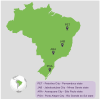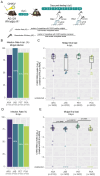The High Capacity of Brazilian Aedes aegypti Populations to Transmit a Locally Circulating Lineage of Chikungunya Virus
- PMID: 38675917
- PMCID: PMC11053879
- DOI: 10.3390/v16040575
The High Capacity of Brazilian Aedes aegypti Populations to Transmit a Locally Circulating Lineage of Chikungunya Virus
Abstract
The incidence of chikungunya has dramatically surged worldwide in recent decades, imposing an expanding burden on public health. In recent years, South America, particularly Brazil, has experienced outbreaks that have ravaged populations following the rapid dissemination of the chikungunya virus (CHIKV), which was first detected in 2014. The primary vector for CHIKV transmission is the urban mosquito species Aedes aegypti, which is highly prevalent throughout Brazil. However, the impact of the locally circulating CHIKV genotypes and specific combinations of local mosquito populations on vector competence remains unexplored. Here, we experimentally analyzed and compared the infectivity and transmissibility of the CHIKV-ECSA lineage recently isolated in Brazil among four Ae. aegypti populations collected from different regions of the country. When exposed to CHIKV-infected AG129 mice for blood feeding, all the mosquito populations displayed high infection rates and dissemination efficiency. Furthermore, we observed that all the populations were highly efficient in transmitting CHIKV to a vertebrate host (naïve AG129 mice) as early as eight days post-infection. These results demonstrate the high capacity of Brazilian Ae. aegypti populations to transmit the locally circulating CHIKV-ECSA lineage. This observation could help to explain the high prevalence of the CHIKV-ECSA lineage over the Asian lineage, which was also detected in Brazil in 2014. However, further studies comparing both lineages are necessary to gain a better understanding of the vector's importance in the epidemiology of CHIKV in the Americas.
Keywords: Aedes aegypti; arbovirus; chikungunya virus; vector competence.
Conflict of interest statement
The authors declare no conflicts of interest.
Figures




Update of
-
High capacity of Brazilian Aedes aegypti populations to transmit a locally circulating lineage of Chikungunya virus.bioRxiv [Preprint]. 2023 Oct 24:2023.10.23.563517. doi: 10.1101/2023.10.23.563517. bioRxiv. 2023. Update in: Viruses. 2024 Apr 09;16(4):575. doi: 10.3390/v16040575. PMID: 37961153 Free PMC article. Updated. Preprint.
References
Publication types
MeSH terms
Grants and funding
LinkOut - more resources
Full Text Sources
Medical

